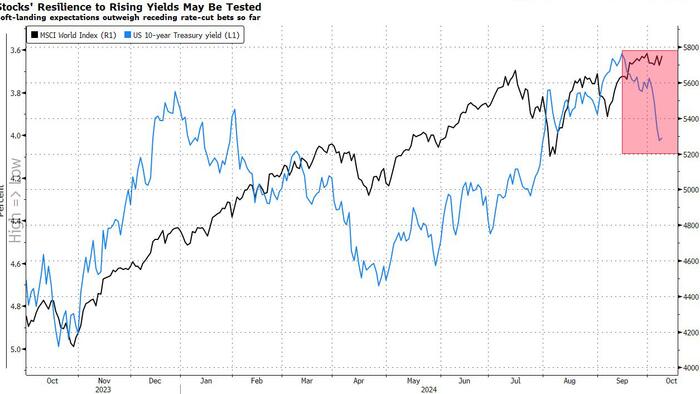In recent developments, the anticipation for rapid interest-rate cuts by the US Federal Reserve has faced significant scrutiny, leading to renewed uncertainty in equity markets. Economic indicators have demonstrated strong performance, prompting a rise in the 10-year Treasury yield, which recently climbed above 4%. This marks its highest level since early August, signaling potential shifts in monetary policy. As a result, the market’s previous expectations of rate cuts are being adjusted, with swap markets now projecting fewer than two reductions of 25 basis points by the end of the year. This shift indicates a change in sentiment, reminiscent of earlier fluctuations observed in the year.
The recent economic data has played a crucial role in shaping market perceptions and investor behavior. The robust performance of the economy has contributed to a reevaluation of the Federal Reserve’s monetary policy strategy. Previously, there was widespread anticipation of multiple rate cuts, reflecting a belief that economic growth could slow down. However, the current data suggests resilience within the economy, compelling traders and analysts to reassess their positions. The implications of this shift are far-reaching, impacting not only bond markets but also influencing the equity markets as investors recalibrate their expectations based on new economic realities.
As the stock market aligns with these changing interest rate expectations, volatility can be expected. Investors are adapting to the new narrative, adjusting their strategies in response to the rising Treasury yields and the diminishing likelihood of immediate rate cuts. The initial optimism about the Fed’s easing policy has been tempered by the realization that strong economic indicators may lead to a more cautious approach from policymakers. This transformation in market sentiment could lead to fluctuations in stock prices as participants seek to navigate the evolving landscape of interest rates and economic performance.
Moreover, the impact of these developments on various sectors of the stock market cannot be overstated. Higher Treasury yields often lead to increased borrowing costs, which can affect corporate profitability and investment decisions. Sectors that are sensitive to interest rates, such as utilities and real estate, may face headwinds as borrowing becomes more expensive. Conversely, financial stocks could benefit from a rise in yields, as it improves profit margins for banks and other lending institutions. Thus, investors are closely monitoring sector-specific responses to the changing interest rate environment, adjusting their portfolios to manage risk while capitalizing on potential opportunities.
In summary, the shift in interest rate expectations driven by strong economic data has introduced a layer of complexity to equity markets. The implication of reduced anticipated cuts by the Federal Reserve has prompted investors to navigate a new normal characterized by heightened volatility and shifting narratives. This evolving scenario highlights the interconnectedness of economic performance, monetary policy, and market behavior, as stakeholders adjust to the implications of rising Treasury yields and their effects on various sectors. The coming months will be pivotal, determining how equity markets respond to evolving economic indicators and the Federal Reserve’s subsequent actions.
Ultimately, the financial landscape remains dynamic, with the interplay between economic health and interest rate policy continuing to shape market sentiment. Investors must stay vigilant, balancing the need for strategic positioning amid uncertainty with the ongoing interpretation of economic data. As markets adapt to these changes, it is crucial for participants to maintain flexibility in their investment approaches, ready to capitalize on opportunities while mitigating risks associated with shifting monetary policy and economic conditions.

